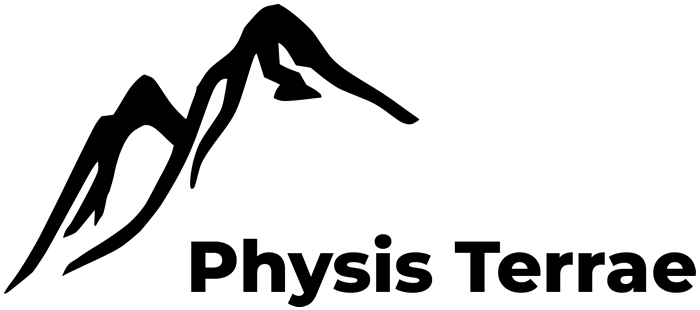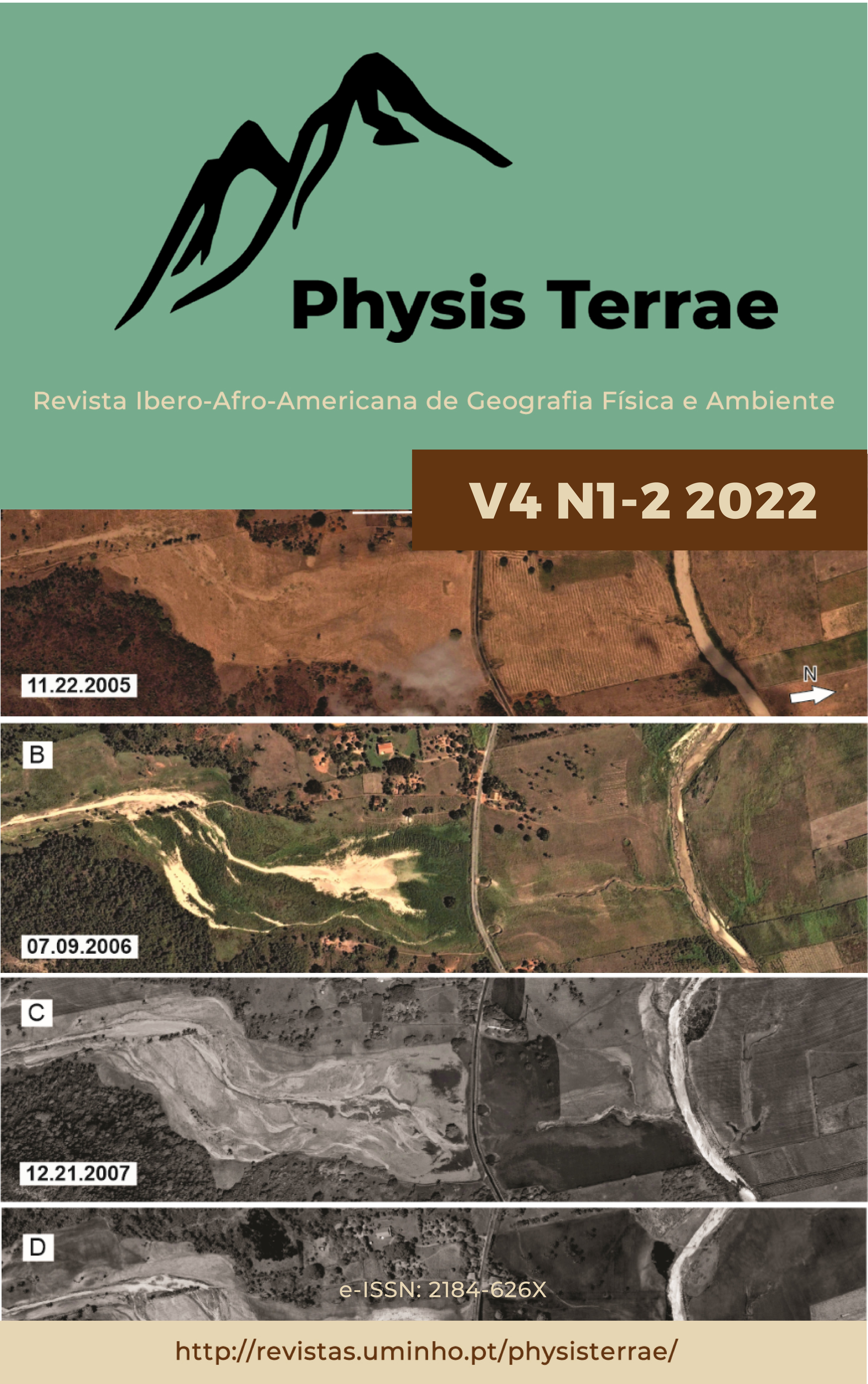Avaliação da regeneração da vegetação pós-incêndio no Parque Nacional da Chapada Diamantina do Brasil através de sensoriamento remoto
DOI:
https://doi.org/10.21814/physisterrae.4482Palavras-chave:
Google Earth Engine, Landsat 8, Regeneração da vegetação, Incêndios florestais, NBRResumo
A compreensão da dinâmica do fogo na vegetação é essencial para avaliar os impactes causados pela ação dos incêndios florestais, especialmente porque a queima de biomassa nos ecossistemas tem sido indicada como um dos principais fatores que impactam o clima e a biodiversidade. Uma alternativa atual para detetar incêndios através de dados de satélite são as plataformas de processamento em nuvens, como o Google Earth Engine (GEE). Dado este contexto, o presente trabalho visa avaliar o grau de recuperação da vegetação após um evento de incêndio numa área incluída no Parque Nacional da Chapada Diamantina (Bahia - Brasil) com base na aplicação da Razão de Queimada Normalizada (NBR) em conjuntos de dados Landsat Surface Reflectance Tier 1. As imagens foram acessadas e processadas na plataforma GEE. O índice NBR revelou-se mais sensível aos deslocamentos pré e pós-fogo dos pixels afetados pelos incêndios entre as bandas de imagem Landsat NIR e SWIR. Verificou-se que os valores médios do NBR diminuíram imediatamente após a ocorrência do incêndio em toda a área de estudo. Após o incêndio, os valores médios do NBR foram apontando no sentido do retorno a condições similares àquelas que o precederam, indicando os valores de NBR que a biomassa vegetal, nove meses após o incêndio, já apresentava uma considerável recuperação. Neste sentido, este estudo demonstra a necessidade de se conhecer melhor a dinâmica dos incêndios na região do Parque Nacional da Chapada Diamantina e os impactes associado a estes eventos, no que respeita à ecologia do fogo.
Downloads
Referências
Alencar, A. A. C., Arruda, V. L. S., Vieira, W., Conciani, D. E., Costa, D. P., Crusco, N., Duverger, S. G., Ferreira, N. C., Franca-rocha, W., Hasenack, H., Felipe, L., Martenexen, M., Piontekowski, V. J., Ribeiro, N. V., Rosa, E. R., Rosa, M. R., Moura, S., Santos, B., Shimbo, J. Z., & Eduardo, V. (2022). Long-Term Landsat-Based Monthly Burned Area Dataset for the Brazilian Biomes Using Deep Learning. DOI: https://doi.org/10.3390/rs14112510
Araújo, T., & Conceição, A. A. (2021). High functional redundancy drives vegetation recovery in Campo rupestre affected by wildfires. Flora, 281, 151866. https://doi.org/10.1016/j.flora.2021.151866 DOI: https://doi.org/10.1016/j.flora.2021.151866
Bento-Gonçalves, A., Ferreira-Leite, F., & Vieira, A. (2019). Frequência, Intensidade e Severidade, três conceitos-chave no estudo dos incêndios florestais. In Os incêndios florestais em busca de um novo paradigma. https://doi.org/https://doi.org/10.34037/978-972-8330-25-5_2 Coimbra DOI: https://doi.org/10.34037/978-972-8330-25-5_2_2
Bento-Gonçalves, A., & Vieira, A. (2020). Wildfires in the wildland-urban interface: Key concepts and evaluation methodologies. Science of The Total Environment, 707, 135592. https://doi.org/10.1016/j.scitotenv.2019.135592 DOI: https://doi.org/10.1016/j.scitotenv.2019.135592
Bento-Gonçalves, A., Vieira, A., Baptista, G., Rocha, J., & Santos, S. M. B. (2019). The 2017 Large Wildfire of Braga - Evaluation of the Different Conditions of the Burned Vegetation. GeoEcoTrop, 43(4), 627–640.
Bento-gonçalves, A., Vieira, A., Úbeda, X., & Martin, D. (2012). Geoderma Fire and soils : Key concepts and recent advances. Geoderma. https://doi.org/10.1016/j.geoderma.2012.01.004 DOI: https://doi.org/10.1016/j.geoderma.2012.01.004
Bond, W., & Keeley, J. (2005). Fire as a global ‘herbivore’: the ecology and evolution of flammable ecosystems. Trends in Ecology & Evolution, 20(7), 387–394. https://doi.org/10.1016/j.tree.2005.04.025 DOI: https://doi.org/10.1016/j.tree.2005.04.025
Chuvieco, E., Aguado, I., Yebra, M., Nieto, H., Salas, J., Martín, M. P., Vilar, L., Martínez, J., Martín, S., Ibarra, P., de la Riva, J., Baeza, J., Rodríguez, F., Molina, J. R., Herrera, M. A., & Zamora, R. (2010). Development of a framework for fire risk assessment using remote sensing and geographic information system technologies. Ecological Modelling, 221(1), 46–58. https://doi.org/10.1016/j.ecolmodel.2008.11.017 DOI: https://doi.org/10.1016/j.ecolmodel.2008.11.017
Doerr, S. H., Shakesby, R. A., Blake, W. H., Chafer, C. J., Humphreys, G. S., & Wallbrink, P. J. (2006). Effects of differing wildfire severities on soil wettability and implications for hydrological response. Journal of Hydrology, 319(1–4), 295–311. https://doi.org/10.1016/j.jhydrol.2005.06.038 DOI: https://doi.org/10.1016/j.jhydrol.2005.06.038
Escuin, S., Navarro, R., & Fernández, P. (2008). Fire severity assessment by using NBR (Normalized Burn Ratio) and NDVI (Normalized Difference Vegetation Index) derived from LANDSAT TM/ETM images. International Journal of Remote Sensing, 29(4), 1053–1073. https://doi.org/10.1080/01431160701281072 DOI: https://doi.org/10.1080/01431160701281072
Ferreira-Leite, F., Lourenço, L., & Bento-Golçalves, A. (2013). Large forest fires in mainland Portugal, brief characterization. Méditerranée, 121, 53–65. https://doi.org/10.4000/mediterranee.6863 DOI: https://doi.org/10.4000/mediterranee.6863
Foga, S., Scaramuzza, P. L., Guo, S., Zhu, Z., Dilley, R. D., Beckmann, T., Schmidt, G. L., Dwyer, J. L., Joseph Hughes, M., & Laue, B. (2017). Cloud detection algorithm comparison and validation for operational Landsat data products. Remote Sensing of Environment, 194, 379–390. https://doi.org/10.1016/j.rse.2017.03.026 DOI: https://doi.org/10.1016/j.rse.2017.03.026
Franca-Rocha, W., Santos, S. M. B. dos, Bento-Gonçalves, A., & Ferreira-Leite, F. (2017). Are there mega fires in Brazilian Savannas? The national park of Chapada Diamantina Case (Bahia, Brazil). In Wildfores: Perspectives, Issues and Challenges of the 21st century. Nova Science Publishers.
French, N. H. F., Kasischke, E. S., Hall, R. J., Murphy, K. A., Verbyla, D. L., Hoy, E. E., & Allen, J. L. (2008). Using Landsat data to assess fire and burn severity in the North American boreal forest region: an overview and summary of results. International Journal of Wildland Fire, 17(4), 443. https://doi.org/10.1071/WF08007 DOI: https://doi.org/10.1071/WF08007
Gonçalves, C. N., Mesquita, F. W., Lima, N. R. G., Coslope, L. A., & Lintomen, B. S. (2011). Recorrência dos Incêndios e Fitossociologia da Vegetação em Áreas com Diferentes Regimes de Queima no Parque Nacional da Chapada Diamantina. Biodiversidade Brasileira, 1(2), 161–179.
Gorelick, N., Hancher, M., Dixon, M., Ilyushchenko, S., Thau, D., & Moore, R. (2017). Google Earth Engine: Planetary-scale geospatial analysis for everyone. Remote Sensing of Environment, 202, 18–27. https://doi.org/10.1016/j.rse.2017.06.031 DOI: https://doi.org/10.1016/j.rse.2017.06.031
Gouveia, C., DaCamara, C. C., & Trigo, R. M. (2010). Post-fire vegetation recovery in Portugal based on spot/vegetation data. Natural Hazards and Earth System Science, 10(4), 673–684. https://doi.org/10.5194/nhess-10-673-2010 DOI: https://doi.org/10.5194/nhess-10-673-2010
Granged, A. J. P., Jordán, A., Zavala, L. M., Muñoz-Rojas, M., & Mataix-Solera, J. (2011). Short-term effects of experimental fire for a soil under eucalyptus forest (SE Australia). Geoderma, 167–168, 125–134. https://doi.org/10.1016/j.geoderma.2011.09.011 DOI: https://doi.org/10.1016/j.geoderma.2011.09.011
Hansen, M. C., Potapov, P. V., Moore, R., Hancher, M., Turubanova, S. A., Tyukavina, A., Thau, D., Stehman, S. V., Goetz, S. J., Loveland, T. R., Kommareddy, A., Egorov, A., Chini, L., Justice, C. O., & Townshend, J. R. G. (2013). High-Resolution Global Maps of 21st-Century Forest Cover Change. Science, 342(6160), 850–853. https://doi.org/10.1126/science.1244693 DOI: https://doi.org/10.1126/science.1244693
Johansen, K., Phinn, S., & Taylor, M. (2015). Mapping woody vegetation clearing in Queensland, Australia from Landsat imagery using the Google Earth Engine. Remote Sensing Applications: Society and Environment, 1, 36–49. https://doi.org/10.1016/j.rsase.2015.06.002 DOI: https://doi.org/10.1016/j.rsase.2015.06.002
Key, C. H., & Benson, N. C. (2006). Landscape assessment: Sampling and analysis methods. In USDA Forest Service General Technical Report RMRS-GTR-164-CD (pp. 1–55).
Leite, C. C. S. S., Santos, S. M. B., Franca-Rocha, W. J. S., Silva, A. B., & Baptista, G. M. M. (2017). Análise dos incêndios ocorridos no parque nacional da cha-pada diamantina-bahia em 2008 e 2015 com suporte em ín-dices espectrais de vegetação. Revista Brasileira de Cartografia, 69(6). http://www.seer.ufu.br/index.php/revistabrasileiracartografia/article/view/44315 DOI: https://doi.org/10.14393/rbcv69n6-44315
Meng, Q., & Meentemeyer, R. K. (2011). Modeling of multi-strata forest fire severity using Landsat TM data. International Journal of Applied Earth Observation and Geoinformation, 13(1), 120–126. https://doi.org/10.1016/j.jag.2010.08.002 DOI: https://doi.org/10.1016/j.jag.2010.08.002
Morresi, D., Vitali, A., Urbinati, C., & Garbarino, M. (2019). Forest Spectral Recovery and Regeneration Dynamics in Stand-Replacing Wildfires of Central Apennines Derived from Landsat Time Series. Remote Sensing, 11(3), 308. https://doi.org/10.3390/rs11030308 DOI: https://doi.org/10.3390/rs11030308
Neves, S. P. S., & Conceição, A. A. (2010). Campo rupestre recém-queimado na Chapada Diamantina, Bahia, Brasil: plantas de rebrota e sementes, com espécies endêmicas na rocha. Acta Botanica Brasilica, 24(3), 697–707. https://doi.org/10.1590/S0102-33062010000300013 DOI: https://doi.org/10.1590/S0102-33062010000300013
Parker, B. M., Lewis, T., & Srivastava, S. K. (2015). Estimation and evaluation of multi-decadal fire severity patterns using Landsat sensors. Remote Sensing of Environment, 170, 340–349. https://doi.org/10.1016/j.rse.2015.09.014 DOI: https://doi.org/10.1016/j.rse.2015.09.014
Parks, S., Holsinger, L., Voss, M., Loehman, R., & Robinson, N. (2018). Mean Composite Fire Severity Metrics Computed with Google Earth Engine Offer Improved Accuracy and Expanded Mapping Potential. Remote Sensing, 10(6), 879. https://doi.org/10.3390/rs10060879 DOI: https://doi.org/10.3390/rs10060879
Robichaud, P. R., Lewis, S. A., Laes, D. Y. M., Hudak, A. T., Kokaly, R. F., & Zamudio, J. A. (2007). Postfire soil burn severity mapping with hyperspectral image unmixing. Remote Sensing of Environment, 108(4), 467–480. https://doi.org/10.1016/j.rse.2006.11.027 DOI: https://doi.org/10.1016/j.rse.2006.11.027
Rogan, J., & Yool, S. R. (2001). Mapping fire-induced vegetation depletion in the Peloncillo Mountains, Arizona and New Mexico. International Journal of Remote Sensing, 22(16), 3101–3121. https://doi.org/10.1080/01431160152558279 DOI: https://doi.org/10.1080/01431160152558279
Ryu, J.-H., Han, K.-S., Hong, S., Park, N.-W., Lee, Y.-W., & Cho, J. (2018). Satellite-Based Evaluation of the Post-Fire Recovery Process from the Worst Forest Fire Case in South Korea. Remote Sensing, 10(6), 918. https://doi.org/10.3390/rs10060918 DOI: https://doi.org/10.3390/rs10060918
Santos, S. M. B. dos, Bento-Gonçalves, A., Franca-Rocha, W., & Baptista, G. (2020). Assessment of Burned Forest Area Severity and Postfire Regrowth in Chapada Diamantina National Park (Bahia, Brazil) Using dNBR and RdNBR Spectral Indices. Geosciences, 10(3), 106. https://doi.org/10.3390/geosciences10030106 DOI: https://doi.org/10.3390/geosciences10030106
Santos, S. M. B. dos, Bento-Gonçalves, A., & Vieira, A. (2021). Research on Wildfires and Remote Sensing in the Last Three Decades: A Bibliometric Analysis. Forests, 12(5), 604. https://doi.org/10.3390/f12050604 DOI: https://doi.org/10.3390/f12050604
Santos, J. F., Soares, R. V., & Batista, A. C. (2006). PERFIL DOS INCÊNDIOS FLORESTAIS NO BRASIL EM ÁREAS PROTEGIDAS NO PERÍODO DE 1998 A 2002. 93–100. DOI: https://doi.org/10.5380/rf.v36i1.5510
Santos, S., Franca-Rocha, W. J. S., Bento-Gonçalves, A., & Baptista, G. M. M. (2017). Quantificação e avaliação dos focos de calor no parque na-cional da chapada diamantina e entorno no período de 2007 a 2016. Revista Brasileira de Cartografia, 69(4). http://www.seer.ufu.br/index.php/revistabrasileiracartografia/article/view/44329 DOI: https://doi.org/10.14393/rbcv69n4-44329
Sonnenschein, R., Kuemmerle, T., Udelhoven, T., Stellmes, M., & Hostert, P. (2011). Differences in Landsat-based trend analyses in drylands due to the choice of vegetation estimate. Remote Sensing of Environment, 115(6), 1408–1420. https://doi.org/10.1016/j.rse.2011.01.021 DOI: https://doi.org/10.1016/j.rse.2011.01.021
Soulard, C., Albano, C., Villarreal, M., & Walker, J. (2016). Continuous 1985–2012 Landsat Monitoring to Assess Fire Effects on Meadows in Yosemite National Park, California. Remote Sensing, 8(5), 371. https://doi.org/10.3390/rs8050371 DOI: https://doi.org/10.3390/rs8050371
Srivastava, S. K., King, L., Mitchell, C., Wiegand, A., Carter, R. W., Shapcott, A., & Russell-Smith, J. (2013). Ecological implications of standard fire-mapping approaches for fire management of the World Heritage Area, Fraser Island, Australia. International Journal of Wildland Fire, 22(3), 381. https://doi.org/10.1071/WF11037 DOI: https://doi.org/10.1071/WF11037
Sunderman, S. O., & Weisberg, P. J. (2011). Remote sensing approaches for reconstructing fire perimeters and burn severity mosaics in desert spring ecosystems. Remote Sensing of Environment, 115(9), 2384–2389. https://doi.org/10.1016/j.rse.2011.05.001 DOI: https://doi.org/10.1016/j.rse.2011.05.001
Veraverbeke, S., Lhermitte, S., Verstraeten, W. W., & Goossens, R. (2010). The temporal dimension of differenced Normalized Burn Ratio (dNBR) fire/burn severity studies: The case of the large 2007 Peloponnese wildfires in Greece. Remote Sensing of Environment, 114(11), 2548–2563. https://doi.org/10.1016/j.rse.2010.05.029 DOI: https://doi.org/10.1016/j.rse.2010.05.029
Veraverbeke, Sander, Stavros, E. N., & Hook, S. J. (2014). Assessing fire severity using imaging spectroscopy data from the Airborne Visible/Infrared Imaging Spectrometer (AVIRIS) and comparison with multispectral capabilities. Remote Sensing of Environment, 154, 153–163. https://doi.org/10.1016/j.rse.2014.08.019 DOI: https://doi.org/10.1016/j.rse.2014.08.019
Westerling, A. l., Hidalgo, H. G., Cayan, D. R., & Swetnam, T. W. (2006). Warming and Earlier Spring Increase Western U.S. Forest Wildfire Activity. Science, 1161(August), 940–944. DOI: https://doi.org/10.1126/science.1128834
Wimberly, M. C., & Reilly, M. J. (2007). Assessment of fire severity and species diversity in the southern Appalachians using Landsat TM and ETM+ imagery. Remote Sensing of Environment, 108(2), 189–197. https://doi.org/10.1016/j.rse.2006.03.019 DOI: https://doi.org/10.1016/j.rse.2006.03.019
Downloads
Publicado
Como Citar
Edição
Secção
Licença
Direitos de Autor (c) 2022 Sarah Moura Batista dos Santos, António Bento-Gonçalves, António Vieira, Jonathas Santos, Khalil Ali Ganem, Washington Franca-Rocha, Raiânnata Machado Figueiredo, Soltan Galano Duverger

Este trabalho encontra-se publicado com a Licença Internacional Creative Commons Atribuição 4.0.




